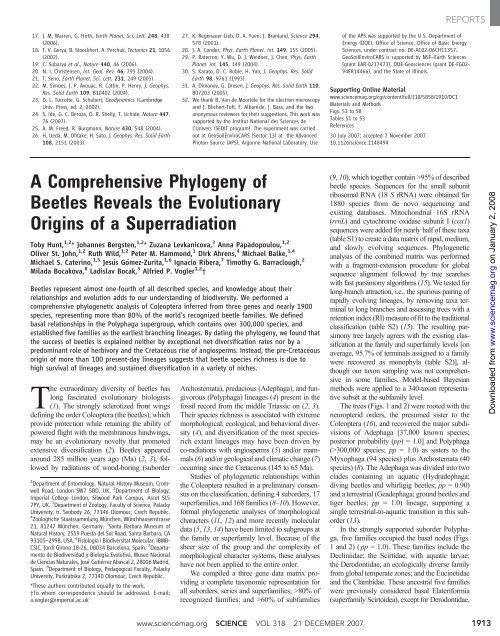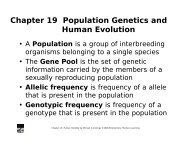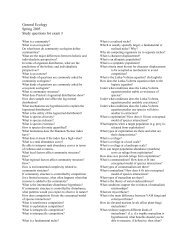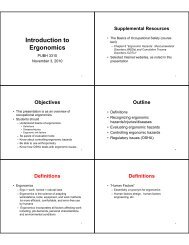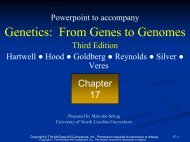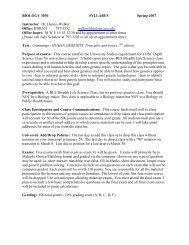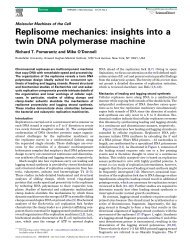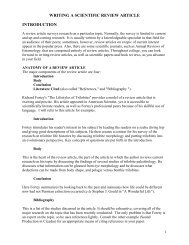Hunt et al. 2007
Hunt et al. 2007
Hunt et al. 2007
You also want an ePaper? Increase the reach of your titles
YUMPU automatically turns print PDFs into web optimized ePapers that Google loves.
17. J. M. Warren, G. Hirth, Earth Plan<strong>et</strong>. Sci. L<strong>et</strong>t. 248, 438<br />
(2006).<br />
18. T. V. Gerya, B. Stoeckhert, A. Perchuk, Tectonics 21, 1056<br />
(2002).<br />
19. C. Subarya <strong>et</strong> <strong>al</strong>., Nature 440, 46 (2006).<br />
20. N. I. Christensen, Int. Geol. Rev. 46, 795 (2004).<br />
21. T. Seno, Earth Plan<strong>et</strong>. Sci. L<strong>et</strong>t. 231, 249 (2005).<br />
22. M. Simoes, J. P. Avouac, R. Cattin, P. Henry, J. Geophys.<br />
Res. Solid Earth 109, B10402 (2004).<br />
23. D. L. Turcotte, G. Schubert, Geodynamics (Cambridge<br />
Univ. Press, ed. 2, 2002).<br />
24. S. Ide, G. C. Beroza, D. R. Shelly, T. Uchide, Nature 447,<br />
76 (<strong>2007</strong>).<br />
25. A. M. Freed, R. Burgmann, Nature 430, 548 (2004).<br />
26. H. Ueda, M. Ohtake, H. Sato, J. Geophys. Res. Solid Earth<br />
108, 2151 (2003).<br />
27. K. Regenauer-Lieb, D. A. Yuen, J. Branlund, Science 294,<br />
578 (2001).<br />
28. J. A. Conder, Phys. Earth Plan<strong>et</strong>. Int. 149, 155 (2005).<br />
29. P. Raterron, Y. Wu, D. J. Weidner, J. Chen, Phys. Earth<br />
Plan<strong>et</strong>. Int. 145, 149 (2004).<br />
30. S. Karato, D. C. Rubie, H. Yan, J. Geophys. Res. Solid<br />
Earth 98, 9761 (1993).<br />
31. A. Dimanov, G. Dresen, J. Geophys. Res. Solid Earth 110,<br />
B07203 (2005).<br />
32. We thank B. Van de Moortèle for the electron microscopy<br />
and J. Blichert-Toft, F. Albarède, J. Bass, and the two<br />
anonymous reviewers for their suggestions. This work was<br />
supported by the Institut Nation<strong>al</strong> des Sciences de<br />
l’Univers (SEDIT program). The experiment was carried<br />
out at GeoSoilEnviroCARS (Sector 13) at the Advanced<br />
Photon Source (APS), Argonne Nation<strong>al</strong> Laboratory. Use<br />
of the APS was supported by the U.S. Department of<br />
Energy (DOE), Office of Science, Office of Basic Energy<br />
Sciences, under contract no. DE-AC02-06CH11357.<br />
GeoSoilEnviroCARS is supported by NSF–Earth Sciences<br />
(grant EAR-0217473), DOE-Geosciences (grant DE-FG02-<br />
94ER14466), and the State of Illinois.<br />
Supporting Online Materi<strong>al</strong><br />
www.sciencemag.org/cgi/content/full/318/5858/1910/DC1<br />
Materi<strong>al</strong>s and M<strong>et</strong>hods<br />
Figs. S1 to S8<br />
Tables S1 to S3<br />
References<br />
30 July <strong>2007</strong>; accepted 7 November <strong>2007</strong><br />
10.1126/science.1148494<br />
REPORTS<br />
A Comprehensive Phylogeny of<br />
Be<strong>et</strong>les Reve<strong>al</strong>s the Evolutionary<br />
Origins of a Superradiation<br />
Toby <strong>Hunt</strong>, 1,2 * Johannes Bergsten, 1,2 * Zuzana Levkanicova, 3 Anna Papadopoulou, 1,2<br />
Oliver St. John, 1,2 Ruth Wild, 1,2 P<strong>et</strong>er M. Hammond, 1 Dirk Ahrens, 4 Michael B<strong>al</strong>ke, 1,4<br />
Michael S. Caterino, 1,5 Jesús Gómez-Zurita, 1,6 Ignacio Ribera, 7 Timothy G. Barraclough, 2<br />
Milada Bocakova, 8 Ladislav Bocak, 3 Alfried P. Vogler 1,2 †<br />
Be<strong>et</strong>les represent <strong>al</strong>most one-fourth of <strong>al</strong>l described species, and knowledge about their<br />
relationships and evolution adds to our understanding of biodiversity. We performed a<br />
comprehensive phylogen<strong>et</strong>ic an<strong>al</strong>ysis of Coleoptera inferred from three genes and nearly 1900<br />
species, representing more than 80% of the world’s recognized be<strong>et</strong>le families. We defined<br />
bas<strong>al</strong> relationships in the Polyphaga supergroup, which contains over 300,000 species, and<br />
established five families as the earliest branching lineages. By dating the phylogeny, we found that<br />
the success of be<strong>et</strong>les is explained neither by exception<strong>al</strong> n<strong>et</strong> diversification rates nor by a<br />
predominant role of herbivory and the Cr<strong>et</strong>aceous rise of angiosperms. Instead, the pre-Cr<strong>et</strong>aceous<br />
origin of more than 100 present-day lineages suggests that be<strong>et</strong>le species richness is due to<br />
high surviv<strong>al</strong> of lineages and sustained diversification in a vari<strong>et</strong>y of niches.<br />
The extraordinary diversity of be<strong>et</strong>les has<br />
long fascinated evolutionary biologists<br />
(1). The strongly sclerotized front wings<br />
defining the order Coleoptera (the be<strong>et</strong>les), which<br />
provide protection while r<strong>et</strong>aining the ability of<br />
powered flight with the membranous hindwings,<br />
may be an evolutionary novelty that promoted<br />
extensive diversification (2). Be<strong>et</strong>les appeared<br />
around 285 million years ago (Ma) (2, 3), followed<br />
by radiations of wood-boring (suborder<br />
1 Department of Entomology, Natur<strong>al</strong> History Museum, Cromwell<br />
Road, London SW7 5BD, UK. 2 Department of Biology,<br />
Imperi<strong>al</strong> College London, Silwood Park Campus, Ascot SL5<br />
7PY, UK. 3 Department of Zoology, Faculty of Science, P<strong>al</strong>acky<br />
University, tr. Svobody 26, 77146 Olomouc, Czech Republic.<br />
4 Zoologische Staatssammlung München, Münchhausenstrasse<br />
21, 81247 München, Germany. 5 Santa Barbara Museum of<br />
Natur<strong>al</strong> History, 2559 Puesta del Sol Road, Santa Barbara, CA<br />
93105–2998, USA. 6 Fisiologia i Biodiversitat Molecular, IBMB-<br />
CSIC, Jordi Girona 18-26, 08034 Barcelona, Spain. 7 Departamento<br />
de Biodiversidad y Biología Evolutiva, Museo Nacion<strong>al</strong><br />
de Ciencias Natur<strong>al</strong>es, José Gutiérrez Abasc<strong>al</strong> 2, 28006 Madrid,<br />
Spain. 8 Department of Biology, Pedagogic<strong>al</strong> Faculty, P<strong>al</strong>acky<br />
University, Purkrabska 2, 77140 Olomouc, Czech Republic.<br />
*These authors contributed equ<strong>al</strong>ly to the work.<br />
†To whom correspondence should be addressed. E-mail:<br />
a.vogler@imperi<strong>al</strong>.ac.uk<br />
Archostemata), predacious (Adephaga), and fungivorous<br />
(Polyphaga) lineages (4) present in the<br />
fossil record from the middle Triassic on (2, 3).<br />
Their species richness is associated with extreme<br />
morphologic<strong>al</strong>, ecologic<strong>al</strong>, and behavior<strong>al</strong> diversity<br />
(4), and diversification of the most speciesrich<br />
extant lineages may have been driven by<br />
co-radiations with angiosperms (5) and/ormamm<strong>al</strong>s<br />
(6) and/or geologic<strong>al</strong> and climatic change (7)<br />
occurring since the Cr<strong>et</strong>aceous (145 to 65 Ma).<br />
Studies of phylogen<strong>et</strong>ic relationships within<br />
the Coleoptera resulted in a preliminary consensus<br />
on the classification, defining 4 suborders, 17<br />
superfamilies, and 168 families (8–10). However,<br />
form<strong>al</strong> phylogen<strong>et</strong>ic an<strong>al</strong>yses of morphologic<strong>al</strong><br />
characters (11, 12) and more recently molecular<br />
data (5, 13, 14) have been limited to subgroups at<br />
the family or superfamily level. Because of the<br />
sheer size of the group and the complexity of<br />
morphologic<strong>al</strong> character systems, these an<strong>al</strong>yses<br />
have not been applied to the entire order.<br />
We compiled a three gene data matrix providing<br />
a compl<strong>et</strong>e taxonomic representation for<br />
<strong>al</strong>l suborders, series and superfamilies; >80% of<br />
recognized families; and >60% of subfamilies<br />
(9, 10), which tog<strong>et</strong>her contain >95% of described<br />
be<strong>et</strong>le species. Sequences for the sm<strong>al</strong>l subunit<br />
ribosom<strong>al</strong> RNA (18 S rRNA) were obtained for<br />
1880 species from de novo sequencing and<br />
existing databases. Mitochondri<strong>al</strong> 16S rRNA<br />
(rrnL) and cytochrome oxidase subunit I (cox1)<br />
sequences were added for nearly h<strong>al</strong>f of these taxa<br />
(table S1) to create a data matrix of rapid, medium,<br />
and slowly evolving sequences. Phylogen<strong>et</strong>ic<br />
an<strong>al</strong>ysis of the combined matrix was performed<br />
with a fragment-extension procedure for glob<strong>al</strong><br />
sequence <strong>al</strong>ignment followed by tree searches<br />
with fast parsimony <strong>al</strong>gorithms (15). We tested for<br />
long-branch attraction, i.e., the spurious pairing of<br />
rapidly evolving lineages, by removing taxa termin<strong>al</strong><br />
to long branches and assessing trees with a<br />
r<strong>et</strong>ention index (RI) measure of fit to the tradition<strong>al</strong><br />
classification (table S2) (15). The resulting parsimony<br />
tree largely agrees with the existing classification<br />
at the family and superfamily levels [on<br />
average, 95.7% of termin<strong>al</strong>s assigned to a family<br />
were recovered as monophyla (table S2)], <strong>al</strong>though<br />
our taxon sampling was not comprehensive<br />
in some families. Model-based Bayesian<br />
m<strong>et</strong>hods were applied to a 340-taxon representative<br />
subs<strong>et</strong> at the subfamily level.<br />
The trees (Figs. 1 and 2) were rooted with the<br />
neuropterid orders, the presumed sister to the<br />
Coleoptera (16), and recovered the major subdivisions<br />
of Adephaga [37,000 known species;<br />
posterior probability (pp) = 1.0] and Polyphaga<br />
(>300,000 species; pp =1.0)assisterstothe<br />
Myxophaga (94 species) plus Archostemata (40<br />
species) (8). The Adephaga was divided into two<br />
clades containing an aquatic (Hydradephaga;<br />
diving be<strong>et</strong>les and whirligig be<strong>et</strong>les; pp =0.90)<br />
and a terrestri<strong>al</strong> (Geadephaga; ground be<strong>et</strong>les and<br />
tiger be<strong>et</strong>les; pp = 1.0) lineage, supporting a<br />
single terrestri<strong>al</strong>-to-aquatic transition in this suborder<br />
(13).<br />
In the strongly supported suborder Polyphaga,<br />
five families occupied the bas<strong>al</strong> nodes (Figs.<br />
1and2)(pp = 1.0). These families include the<br />
Decliniidae; the Scirtidae, with aquatic larvae;<br />
the Derodontidae, an ecologic<strong>al</strong>ly diverse family<br />
from glob<strong>al</strong> temperate zones; and the Eucin<strong>et</strong>idae<br />
and the Clambidae. These ancestr<strong>al</strong> five families<br />
were previously considered bas<strong>al</strong> Elateriformia<br />
(superfamily Scirtoidea), except for Derodontidae,<br />
Downloaded from www.sciencemag.org on January 2, 2008<br />
www.sciencemag.org SCIENCE VOL 318 21 DECEMBER <strong>2007</strong> 1913


